Angelica archangelica
English: angelica | French: angéline officianale | German: Engelwurz
Therapeutic properties
Digestive, antispasmodic, antibacterial, antifungal, diuretic, stimulant. It regulates menstruation and relieves from its pains.
How to use
We make infusion or decoction from the roots or the seeds. We drink 1 – 2 cups a day after meals. Its use should be interrupted every 2 weeks.
Cucumis sativus
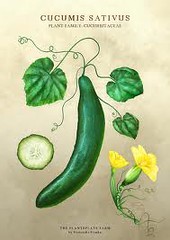 English: cucumber | French: concombre | German: Gurke
English: cucumber | French: concombre | German: Gurke
Therapeutic properties
Diuretic, tranquilizer, hair tonic, astringent. It helps intestine function and it's against renal lithiasis, cholelithiasis, gravel, nephritis, arthritis.
How to use
We eat it. We can use the slices or pulp or porridge for skin and hair care.
Cynara scolymus
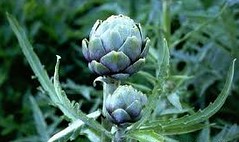 English: artichoke | French: artichaut | German: Artischocke
English: artichoke | French: artichaut | German: Artischocke
Therapeutic properties
It reduces cholesterol and triglycerides, it's against arteriosclerosis, rheumatism and liver disease, it's blood purifying.
How to use
We boil the roots with white wine and we drink. For rheumatism and neuralgia treatment we can use the tincture or the extract of artichoke. The decoction from leaves or stalks can be used for gargles against tonsillitis. For liver disease treatment we can drink 3 cups of decoction per day. The extract should be used on a doctor's prescription and the tincture in a dosage of 6-9 gr, 3 times a day.
Agropyron repens
 English: common couch | French: chiendent commun | German: kriechende Quecke
English: common couch | French: chiendent commun | German: kriechende Quecke
Therapeutic properties
The tisane from common couch is a medicine known worldwide as emollient, refreshing, diuretic and inflammatory especially for intermittent fever, gastrointestinal infections, urinary tracts infections, liver and kidney colic.
How to use
We can make alcohol of an excellent quality by fermenting or distilling the roots. Any proportion is harmless. We can drink the extract, the decoction (20-30 gr in 1 litre of water + a little honey), the juice (from 30-100 gr of young leaves and stalks). We can also let 2 spoonfuls of sliced root soak for a while in 1 litre of water, then we boil for 10 mins and drink 1 glass per day.
Adiantum capillus-veneris
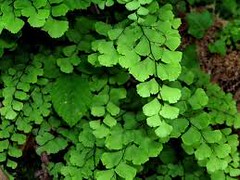 English: maidenhair | French: capillaire | German: Frauenhaar
English: maidenhair | French: capillaire | German: Frauenhaar
Therapeutic properties
Antitussive, expectorant, demulcent in case of dry cough and respiratory infections, it cures dandruff and hair loss.
How to use
For respiratory infections we can drink the infusion. For dandruff treatment we can massage hair roots with cold decoction every day for 2 weeks.
Althaea officinalis
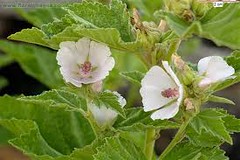 English: marsh mallow | French: mauve | German: Malve
English: marsh mallow | French: mauve | German: Malve
Therapeutic properties
Antitussive, emollient, inflammatory. It relieves muscular pains, effaces bruises, mellows aposthimas, combats gingivitis, mouth ulcers and constipation. It's very effective against stomatitis, pharyngitis, stomach and intestine ulcer.
How to use
We drink the decoction from leaves and flowers against infections and cough (3 cups a day). We can also add decoction in bath water against skin irritations, we can gargle decoction against gingivitis, mouth ulcers, tooth aposthimas. For a more drastic decoction: we boil 100 gr of root in 10 cups of water, let evaporate to its half and filtrate. We use it against internal infections as well as externally against bruises and muscular pains (we spread it on the skin). We can take a sachet of marsh mallow root powder dissolved in a little water every day against constipation.
Aloe vera
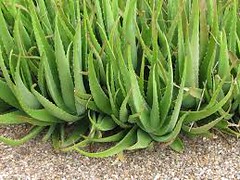 English: aloe | French: aloès | German: Aloe
English: aloe | French: aloès | German: Aloe
Therapeutic properties
Aromatic, stimulative, laxative, apetizing and digestive in small dosage, emollient and vulnerary.
How to use
The yellow bitter juice that flows from leaves when we cut them can be dried and used as a laxative. The leaves themselves when cut and peeled off their membrane can be placed on skin burns, insect bites, cuts. They have an antifungal, antibiotic and inflammatory effect. Aloe is extensively used in cosmetics industry.
Anethum graveolens
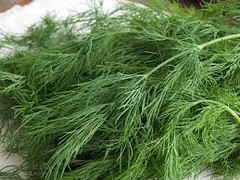 English: dill | French: aneth | German: Dill
English: dill | French: aneth | German: Dill
Therapeutic properties
Diuretic,digestive, against colics, vomit, stomach disorders.
How to use
For decoction we boil 2 tea spoonfuls of dill seeds in 1 litre of water for 10-15 mins. We drink half a cup once or twice a day.
Juniperus communis
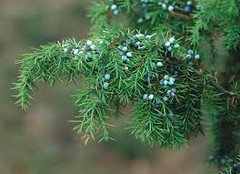 English: juniper | French: genevrier commun |German: Wachholder
English: juniper | French: genevrier commun |German: Wachholder
Therapeutic properties
Against wheeziness, gout, rheumatism. It's a good digestive, tonic.
How to use
Massage with the juice or tincture from fruits relieves from joint pains. Eating the fruits helps with indigestion and burning them helps with respiratory problems. It also decontaminates the air in closed spaces.
Achillea millefolium
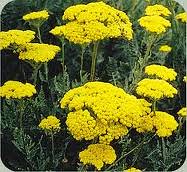 English: yarrow | French: millefeuille | German: Schafgarbe
English: yarrow | French: millefeuille | German: Schafgarbe
Therapeutic properties
Diaphoretic, febrifuge, hemostatic, inflammatory, menstruation regulating, heart stimulative, anti-rheumatism. Against colitis, gastrointestinal diseases, diabetes at its start.
How to use
We drink 3 cups of infusion for quite a long period. We can use the infusion in dressings on the skin, massaging the hair, in a steam bath for the skin greasiness decrease. Inhaling infusion vapour helps with respiratory problems.
Valeriana officinalis
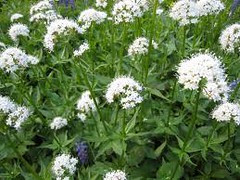 English: valeriana | French: valeriane | German: Baldrian
English: valeriana | French: valeriane | German: Baldrian
Therapeutic properties
Sedative in case of nervous tension, insomnia and stress. Antispasmodic, headache relieving, reduces high blood pressure, calms down hysteria, cough and asthma.
How to use
It must be used for one week only then interrupted for 2-3 weeks. We can use the decoction or the maceration from the roots, we drink 2-3 cups a day. Tincture: 5-10 drops in some water. Small doses of decoction or maceration relieve from headaches, calm the nervous system and fight insomnia.
Hypericum perforatum
 English: common St John's wort | French: millepertuis perfozé | German: Johanniskraut
English: common St John's wort | French: millepertuis perfozé | German: Johanniskraut
Therapeutic properties
Known as “the” herb for healing wounds. It is considered to be very effective for neuralgia, depression, thrombosis, rheumatism, diarrhea, it's a good hemostatic, spasm soothing, revitalising.
How to use
The essence works wonders in healing wounds, burns, bruises, bites, skin eruptions. We massage or spread. For all the above problems we can also apply chopped leaves poultice on the skin. The herb infusion in alcohol as well as the distillate (eau-de-vie-rouge) are widely used. A cup of warm decoction every morning is really beneficial.
Ocymum basilicum
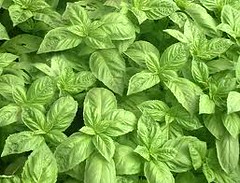 English: basil | French: basillic |German: Basilikum
English: basil | French: basillic |German: Basilikum
Therapeutic properties
Stimulative, tonic, antispasmodic, antiseptic, expectorant, against dizziness and migraine.
How to use
It can be dried and pulverized. We can drink the infusion, we can use the tincture from fresh leaves: mixed with wine it becomes a good tonic, mixed with oil it is against constipation, a few drops of tincture act against headaches. Basil powder will help sneezing thus curing rhinitis.
Rubus fructicosus
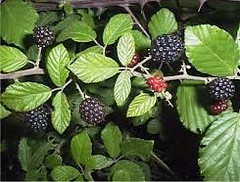 English: bramble | French: ronce commune | German: Brombeere
English: bramble | French: ronce commune | German: Brombeere
Therapeutic properties
Diuretic, anti - diabetic, anti - diarrheal.
How to use
The infusion or decoction from leaves, boiled with a little honey or vinegar, can be used for gargles against pharyngitis, sore throat, gingivitis, mouth ulcers. It will facilitate birth (1 cup per day from 6th month of pregnancy). The sirup from fruit is an excellent anti - diarrheal (we boil bramble juice with double quantity of sugar until it thickens).
Syzygium aromaticum
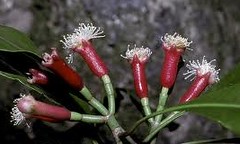 English:carnation | French: oeillet | German: Nelke
English:carnation | French: oeillet | German: Nelke
Therapeutic properties
Carnation oil is a strong antiseptic, it ceases toothache, aborts vomit and nausea. It's an effective digestive, antispasmodic, anti cancer.
How to use
We use carnation oil or decoction for wounds, insect bites, toothache. For nausea we can drink some water with a few drops of carnation oil. Alcoholic drinks with a few drops of carnation oil become good tonics.
Portulaca orelacea
 English: purslane | French: pourpier | German: Portulak
English: purslane | French: pourpier | German: Portulak
Therapeutic properties
The whole plant is useful except for its roots. It's sedative, diuretic, against biliary stones, colitis and amoebas.
How to use
The juice can be used against biliary stones. Daily consumption of the plant in salads helps curing colitis and amoebas.
Anisum vulgare
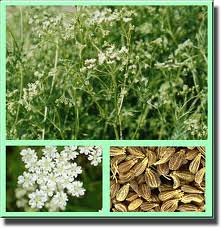 English: anise | French: anis cultivé | German: Anis
English: anise | French: anis cultivé | German: Anis
Therapeutic properties
Diuretic, apetizing, digestive, expectorant, antispasmodic, emmenagogue.
How to use
The oil extracted from seeds can be used slightly diluted. It's a very effective expectorant and lice and other parasites repellent. We can also use the decoction, infusion, maceration and tincture. We make anise maceration by soaking seeds in water for a few hours, then we can take a tea spoonful 3 times per day.
Rosmarinus officinalis
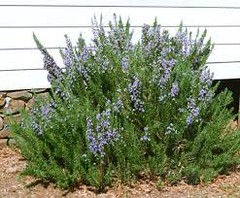 English: rosemary | French: romarin | German: Rosmarin
English: rosemary | French: romarin | German: Rosmarin
Therapeutic properties
Tonic, antispasmodic, emmenagogue, vulnerary, antiseptic, anti rheumatism, headache killer, carminative, helps with indigestion.
How to use
We should be careful with rosemary consumption as in big quantities it might be poisonous. The flowers and leaves are very effective against asthma, flu and pertussis. Poultices and washings are good for the skin. Rosemary in wine is a good heart stimulant, boiled with wine helps people suffering from insomnia. Powder from leaves heals skin wounds, the essence is moth repellent. The decoction can be used for healing gangrene ulcers (we put it on ulcers), rheumatism and swellings (we massage aching parts with it). Rosemary tea prevents fainting. Rosemary flowers clobbered with sugar until they become a paste help with dizziness. Rosemary fresh leaves put on an abscess make it ripen quickly. A piece of cotton wet with rosemary juice and put in the ear will relieve earache. For bruises, wounds, skin eruptions we can use rosemary ointment whereas gargles with infusion will heal mouth ulcers.
Amaracus dictamnus
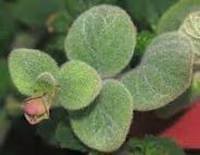 English: dittany | French: dictame | German: Eschenwurzel
English: dittany | French: dictame | German: Eschenwurzel
Therapeutic properties
Tonic, stimulant, antispasmodic, vulnerary, sedative, diuretic, it fights amoebas.
How to use
We can use the decoction or infusion (we drink 2 cups a day). Poultices help heal wounds, ulcers, abscesses. Chewing leaves relieves toothache and headache.
Mentha viridis
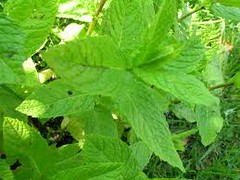 French: menthe | German: Minze
French: menthe | German: Minze
Therapeutic properties
Tonic, stimulant, antispasmodic, diuretic, diaphoretic, against indigestion, vomit, tachycardia, urinary retention, vertigo.
How to use
Washings or poultices are good for skin diseases, the dressings relieve headache. Spearmint tea prevents vomit, spasms, cramps, colics (1 tea spoonful every so often).
Eucalyptus globulus
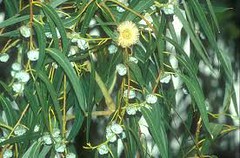 English: eucalyptus | French: eucalyptus | German: Eucalyptus
English: eucalyptus | French: eucalyptus | German: Eucalyptus
Therapeutic properties
Eucalyptus oil is antiseptic, antispasmodic, febrifuge, disinfectant, deodorant, insect killer, vulnerary. It is used for curing respiratory inflammations, cough, asthma, sorethroat. The leaves have antibiotic properties and can be used for decoction making and steam inhaling.
How to use
5-10 drops of eucalyptus oil for chest massage or in boiling water for steam inhalation. We can also boil eucalyptus leaves and inhale the steam which helps get rid of colds. A hot bath with boiled leaves added in the water will also relieve from cold symptoms. We can drink decoction or infusion.
Helianthus anuus
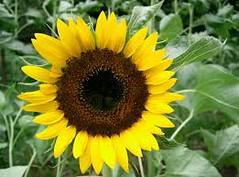 English: sunflower | French: helianthus | German: Sonnenblume
English: sunflower | French: helianthus | German: Sonnenblume
Therapeutic properties
The seeds are nutritional, they calm down the nervous system, prevent bile and kidney stone formation, arthritis. They improve vision. Sunflower oil extracted under cold seed pressure reduces cholesterol and protects from arteriosclerosis.
How to use
We eat the seeds and the oil.
Thymus capitatus
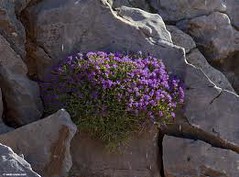 English: thyme | French: thym | German: Gartenthymian
English: thyme | French: thym | German: Gartenthymian
Therapeutic properties
Powerful antiseptic, antispasmodic, digestive, against colics, mites and aciduria. It tranquilizes from cough, bronchitis, pertussis. It increases mental clarity, tonifies nerves, relieves from toothache, helps us sleep (some thyme under the pillow)
How to use
Infusion: against colds, cough, headache, sorethroat (gargles). Ointment or extract: for healing woulds, against itching. Essence: toothache killer, it can be added into bath water (1-5 drops). Decoction: digestive, tonic, against colics (2 cups per day)
Lepidium sativum
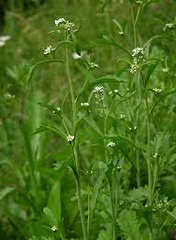 English: garden cress | French: gresson alénois | German: Gartenkresse
English: garden cress | French: gresson alénois | German: Gartenkresse
Therapeutic properties
Appetizing, diuretic, blood purifying, beneficial to the liver, antibiotic.
How to use
It can be eaten as a salad. Its juice mixed with honey is a curing ointment for face freckles.
Hedera helix
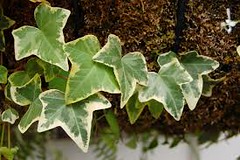 English: ivy | French: lierre | German: Efeu
English: ivy | French: lierre | German: Efeu
Therapeutic properties
Against whooping cough, thrombosis, rhinitis, scurf, scabies, psoriasis and other skin diseases.
How to use
The tincture can be used against rhinitis and whooping cough (10-20 drops per day) the leaves in poultices and the ointment are beneficial for joint pains and skin diseases.
Coriandrum sativum
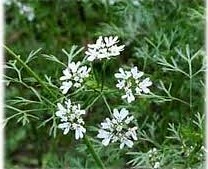 English: coriander | French: coriander cultivée | German: Koriander
English: coriander | French: coriander cultivée | German: Koriander
Therapeutic properties
Digestive, antispasmodic, carminative, intestine regulating, against headaches.
How to use
We can take seed decoction and infusion as a digestive and carminative. Attention! big quantities of coriander juice might cause drunkenness!
Galium aparine
English: grosgrass | French: goillet gratteron | German: Klebkraut
Therapeutic properties
Vulnerary, hypotensive, antispasmodic, inflammatory, anti rheumatism, blood purifier, lithotriptic, against bladder diseases and incontinence.
How to use
We can boil the fresh leaves and plant sprouts and eat them as a salad. Also, wine and tincture can be produced from grosgrass ( the tincture helps with rheumatism).
Colchicum autumnale
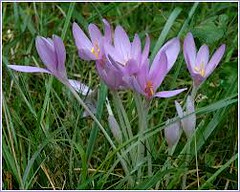 English: meadow saffron | French: colchique d' automne | German: Herbstzeitlose
English: meadow saffron | French: colchique d' automne | German: Herbstzeitlose
Therapeutic properties
Despite the fact that the plant is dangerous because of its toxicity, meadow saffron is precious when used suitably. It's considered a classical medicine against acute gouty arthritis, an effective analgesic (in small dosage it is used against toothache too). Meadow saffron shouldn't be used in cases of renal insufficiency.
How to use
We can use the tincture from seeds (1-5 gr within 24 hours) and the extract but always according to a doctor's advice.
Arbutus unedo
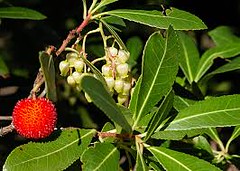 English: strawberry tree | French: arbousier | German: Erdbeerbaum
English: strawberry tree | French: arbousier | German: Erdbeerbaum
Therapeutic properties
Strawberry tree leaves have antiseptic, diuretic, inflammatory and hemostatic properties. Ripened fruit help a lot with constipation.
How to use
The decoction from leaves is very effective for the cure of flu especially if it is mixed with honey and cinnamon. We can also use it for massage to lower fever.
Crocus sativus
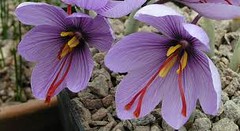 English: saffron | French: safran cultivé | German: echter Safran
English: saffron | French: safran cultivé | German: echter Safran
Therapeutic properties
Emmenagogue, sedative, antispasmodic, tonic, digestive, diuretic.
How to use
We can use the sirup (very effective when massaged on gums, it relieves teething pains) and the infusion. Caution! In big dosage (a few grams!) it might be toxic and cause bleeding.
Lavandula officinalis
 English: lavender | French: lavande officinale | German: Lavendel
English: lavender | French: lavande officinale | German: Lavendel
Therapeutic properties
One of the most effective “medicines” for burns and insect bites. An excellent anti microbe, it exterminates streptococcus and pneumococcus. It's tonic, antispasmodic, stimulant, calming, light sedative, vulnerary, against cough, asthma, flu, laryngitis and headaches.
How to use
We use the infusion, the tincture from fresh flowers for massaging aching parts of the body or skin. We can use dried flowers to repel insects from drawers and wardrobes. Massage with the plant extract relieves from headache, cures bruises and swellings.
Lippia trifylla
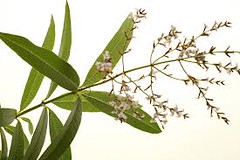 English: Aloysia citrodora | French: verveine odorante | German: Zitronenstrauch
English: Aloysia citrodora | French: verveine odorante | German: Zitronenstrauch
Therapeutic properties
Digestive, against nausea, sedative, nervine.
How to use
We drink infusion from aloysia with honey or sugar. We can also season our food with dried flowers or leaves.
Petroselinum crispum
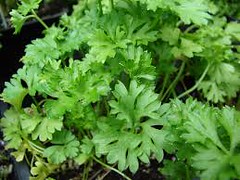 English: parsley | French: persil | German: Petersilie
English: parsley | French: persil | German: Petersilie
Therapeutic properties
Diuretic, liver detoxifier, antispasmodic, stimulant, tonic, appetizing, expectorant. It's against eczema, other skin diseases, edema, indigestion. It's got a beneficial action to blood circulation and rheumatism cure.
How to use
We can drink a wine glass of parsley decoction every morning before eating but not for over 3 consecutive days. For more intensive use it's better to drink the infusion. We can also use the juice from parsley or the decoction from the seeds or poultices with boiled leaves for the cure of skin diseases, insect bites.
Origanum marjorana
 English: marjoram | French: marjolaine | German: Majoran
English: marjoram | French: marjolaine | German: Majoran
Therapeutic properties
Digestive, sedative, stomachache relieving, expectorant, anti diabetes, vulnerary, helps with colds, asthma, tonsillitis, bronchitis.
How to use
We can drink the decoction (2-3 cups a day), the infusion, the tincture (3-4 drops in a teaspoonful of honey, 2-3 times a day). We can inhale hot decoction steam to help us with cough. Dressings wet with decoction as well as massage with the essence are an excellent vulnerary. The seeds can be used in cooking.
Foeniculum vulgare
 English: fennel | French: fenouil | German: Fenchel
English: fennel | French: fenouil | German: Fenchel
Therapeutic properties
Tonic, apetizing, digestive, diuretic, analgesic, expectorant, sedative, helps digest fat so it helps in losing weight.
How to use
We use the leaves infusion as a good digestive, the seed decoction boiled with red wine (2 teaspoonfuls of seeds in ½ litre of wine) is an excellent tonic and appetizing. Chewing seeds prevents the flu. Massage with fennel oil helps reduce edemas.
Melissa officinalis
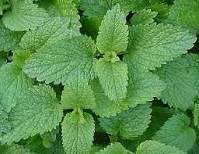 English: balm | French: mélissa officinale | German: Melisse
English: balm | French: mélissa officinale | German: Melisse
Therapeutic properties
Digestive, antispasmodic, anxiolytic, stimulant, tonic, antacid, against indigestion, toothache, it brings longevity.
How to use
We can use poultices against joint pains, massage with juice against headaches, the tea in bath water calms down nerves. We can drink hot infusion or decoction with lemon against colds (2-3 cups a day). The essence is used as a digestive, antispasmodic and sedative ( a few drops in some water). The herb is also used for making the drink “Eau de melisse des Carnes” ( flower sprouts of balm with lemon skin, cinnamon, gloves, nutmeg and coriander soaked in strong white wine).
Malva silvestris
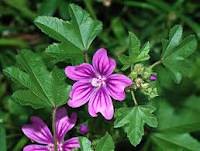 English: common mallow | French: mauve sylvestre | German: wilde Malve
English: common mallow | French: mauve sylvestre | German: wilde Malve
Therapeutic properties
Demulcent, expectorant, laxative, it heals insect bites and itching.
How to use
We use the decoction from leaves in poultices or dressings for the cure of skin eruptions, calluses. Gargles with infusion helps with throat irritations and mouth ulcers. When we drink it it's a good expectorant, it helps cure urinary and stomach diseases( 2-3 glasses per day). We can also drink decoction from the herb roots or flowers (several cups a day).
Atropa belladona
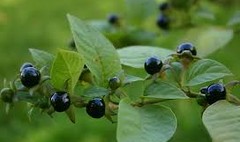 English: deadly nightshade | French: belladone | German: Tollkirsche
English: deadly nightshade | French: belladone | German: Tollkirsche
Therapeutic properties
Antispasmodic, sedative, analgesic, against incontinence, constipation, colics, nausea, dizziness, whooping cough.
How to use
It is used in various forms such as extract, tincture, powder, pills, suppositories but only on a doctor's prescription as, apart from being an effective medicine, it's also extremely poisonous.
Vaccinium myrtillus
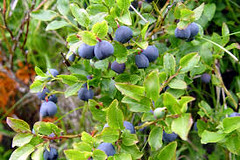 English: bilberry | French: myrtille | German: Heidelbeere
English: bilberry | French: myrtille | German: Heidelbeere
Therapeutic properties
Astringent, disinfectant, anticatarrhal, against diarrhea, common cold, throat infections.
How to use
We can drink the decoction for colds and throat infections. The fruit (10-25 dried or fresh fruit or jam or juice or sirup or compote) are very effective against diarrhea, they are an excellent astringent and disinfectant for the intestine.
Origanum Vulgare
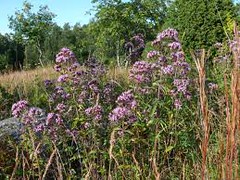 English: oregano | French: origan | German: Oregano
English: oregano | French: origan | German: Oregano
Therapeutic properties
Tonic, apetizing, digestive, antispasmodic, antiseptic, diuretic, astringent.
How to use
The decoction is a very effective antiseptic, diuretic, antispasmodic. The infusion is a good expectorant. We can use oregano oil for massaging aching parts of the body and for healing wounds. Chewing oregano can relieve from toothache.
Orchis mascula
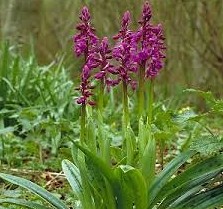 English: early purple orchid | French: orchis male | German: Knabenkraut
English: early purple orchid | French: orchis male | German: Knabenkraut
Therapeutic properties
Demulcent and antidiarrheal.
How to use
We drink tea, we eat jelly, they both are very nutritional and beneficial to convalescent people. The decoction is an excellent demulcent, very effective against diarrhea and throat irritation.
Salvia officinalis
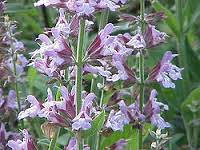 English: sage | French: sauge officinale | German: Salbei
English: sage | French: sauge officinale | German: Salbei
Therapeutic properties
Astringent, sedative, tonic, antidiarrheal, digestive, it helps blood circulation and moderates nervous irritations.
How to use
We drink tea (“greek tea”), infusion to cure nervousness, vertigo, depression. Infusion gargles help cure throat infections, pharyngitis, mouth ulcers. When used in steam baths it's refreshing and it tranquilizes skin irritations. As it causes warming up, it should be avoided by people who suffer from high blood pressure.
Tilia platyphyllos
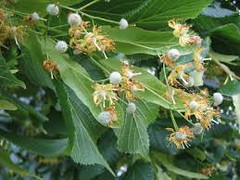 English: linden | French: tilleul | German: Linde
English: linden | French: tilleul | German: Linde
Therapeutic properties
Antitussive, antispasmodic, sedative, slightly hypnotic, against constipation, indigestion, migraine.
How to use
We drink the decoction or infusion from leaves and flowers or plant bark (2-3 cups per day). The decoction is also used externally as a hair tonifier, anti wrinkle and freckle. A bath with decoction helps us calm down.
Mentha aquatica
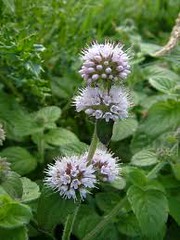 English: water mint | French: menthe aquatique | German: Bachminze
English: water mint | French: menthe aquatique | German: Bachminze
Therapeutic properties
Carminative, anti diarrheal, expectorant, anti rheumatism, anti vomit. Against vertigo and migraines.
How to use
We drink decoction (2-3 cups a day), we massage with essence to cure migraines and vertigo. The leaves extract is a good anti diarrheal. The juice mixed with vinegar is a good anti vomit.
Chamomilla recutita
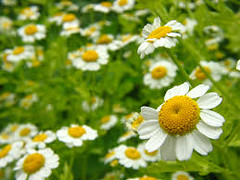 English: camomile | French: camomille | German: Kamille
English: camomile | French: camomille | German: Kamille
Therapeutic properties
Worldwide known for its sedative and antiseptic properties. It's very effective for migraines, anti rheumatism, stimulates blood flow, helps cure colds and allergies.
How to use
We can drink the decoction (2-3 cups a day) or spread it on our skin to cure itching and irritation. We can gargle it as an effective mouth antiseptic. The infusion added in bath water helps us relax. Also the essence is an effective sedative and tranquilizer.
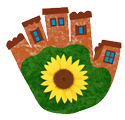

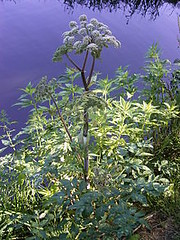
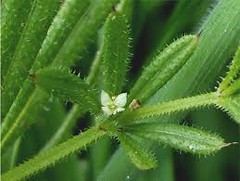

Recent comments